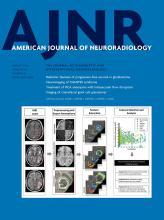Research ArticleHead and Neck Imaging
Deep Learning for Synthetic CT from Bone MRI in the Head and Neck
S. Bambach and M.-L. Ho
American Journal of Neuroradiology August 2022, 43 (8) 1172-1179; DOI: https://doi.org/10.3174/ajnr.A7588
S. Bambach
aFrom the Abigail Wexner Research Institute at Nationwide Children’s Hospital (S.B.), Columbus, Ohio
M.-L. Ho
bDepartment of Radiology (M.-L.H.), Nationwide Children’s Hospital, Columbus, Ohio.

References
- 1.↵
- 2.↵
- 3.↵
- Eley KA,
- McIntyre AG,
- Watt-Smith SR, et al
- 4.↵
- 5.↵
- 6.↵
- Eley KA,
- Watt-Smith SR,
- Golding SJ
- 7.↵
- Lu A,
- Gorny KC,
- Ho ML
- 8.↵
- Cho SB,
- Baek HJ,
- Ryu KH, et al
- 9.↵
- 10.↵
- 11.↵
- 12.↵
- 13.↵
- Leynes AP,
- Yang J,
- Wiesinger F, et al
- 14.
- 15.
- 16.
- 17.↵
- Boukellouz W,
- Moussaoui A
- 18.↵
- Otsu N
- 19.↵
- Ronneberger O,
- Fischer P,
- Brox T
- 20.↵
- Simonyan K,
- Zisserman A
- 21.↵
- Deng J,
- Dong W,
- Socher R, et al
- 22.↵
- Kingma DP,
- Ba J
- 23.↵
- Goodfellow I, et al
- 24.
- Wolterink JM,
- Dinkla Am Savenije MH, et al
- 25.
- Zhu JY,
- Park T,
- Isola P, et al
- 26.↵
- Isola P,
- Zhu JY,
- Zhou T, et al
- 27.↵
- 28.↵
- Kornblith S,
- Shlens J,
- Le QV
- 29.
- Raghu M,
- Zhang C,
- Kleinberg J, et al
- 30.↵
- 31.↵
- 32.↵
- 33.↵
- Bambach S,
- Ho ML
- 34.
- 35.
- 36.↵
- Wiesinger F,
- Ho ML
- 37.↵
- 38.
- 39.
- 40.
- 41.↵
In this issue
American Journal of Neuroradiology
Vol. 43, Issue 8
1 Aug 2022
Advertisement
S. Bambach, M.-L. Ho
Deep Learning for Synthetic CT from Bone MRI in the Head and Neck
American Journal of Neuroradiology Aug 2022, 43 (8) 1172-1179; DOI: 10.3174/ajnr.A7588
0 Responses
Jump to section
Related Articles
- No related articles found.
Cited By...
- No citing articles found.
This article has not yet been cited by articles in journals that are participating in Crossref Cited-by Linking.
More in this TOC Section
Head and Neck Imaging
Similar Articles
Advertisement











